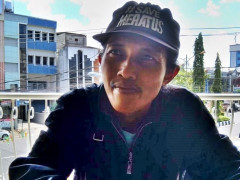Victims of Peatland Conversion: Indigenous People, Migrants, and Biodiversity
By Mudji IsaHope After Eight Years…

Imis’ village of Hapalah is struggling to survive. Most of the village’s 32,000 meters2 is swamp and peatland, and residents have not been able to farm for more than eight years. Since their livelihoods have diminished, most residents – especially the youth – have chosen to leave the village to look for opportunities elsewhere.
About the author: Budi Kurniawan is a journalist and contributor to Pantau Peatland in South Kalimantan.
At 62 years old, he may not be very young anymore, but that doesn’t stop Mistani – better known as Mr. Imis – from joining various events. He is persistent, even attending events on serious subjects, full of theories and scientific ideas. When he visited Danda Jaya village in Batola regency with tens of other field school (sekolah lapang) participants, he diligently listened to the information provided on organic fertilizers and quail breeding. The event was initiated by the Peatland Restoration Agency and Peatland Restoration Regional Team of South Kalimantan in April 2018.
Imis occasionally paused and frowned as he listened to the speaker’s explanation. Once and awhile, he whispered to his fellow villagers from Hapalah in the Banua Lawas sub-district, Tabalong, who were also attending the event.
When the National Peatland Jamboree was held in Kiram village in the Banjar regency in April 2017, Imis was keen to attend many different events. Sometimes, he couldn’t hide his fatigue. This was understandable, given the tight schedule of events and location far from his accommodation in Banjarbaru. "But, for the sake of knowledge enhancement, I follow all the events," explained Imis, a father of seven children and grandfather to 12 grandchildren.
Deep in his heart, Imis is sometimes confused about what he learns from various events. His and his fellow villagers’ reality is so different from the theories presented at official events. Imis’ village of Hapalah is currently miserable. Most of the village’s 32,000 meters2 is swamp and peatland, and residents have not been able to farm for more than eight years.
The village of 287 families is silent. Since their livelihoods have diminished, most residents – especially the youth – have chosen to leave the village to look for opportunities elsewhere. Some go to other regencies in Central Kalimantan. Many young people from Hapalah work as tailors. They return to Hapalah village only during the Eid al-Fitr holiday. "That's the time when we get together. The children come back home," Imis says.
This all began when the large-scale palm oil company PT Cakung Permata Nusa moved in to the village in 2008. The company acquired large land concessions in the area, including on Imis and other villagers’ farmlands.
Imis and the other residents did not accept the company’s presence just like that. Not only did they take over local farmlands, they destroyed other local livelihoods. Hapalah residents have long made use of the swamps and peatlands in their village. In addition to farming on them, local peatland areas have been used to herd residents’ duck flocks. Peatlands have also been used for fishing, another source of livelihood for local people.
Imis led the resistance movement against the palm oil company. The community’s bumpy, but continued, resistance, assisted by environmental activists in South Kalimantan, finally paid off. The company eventually shut down operations in the area, because every time they tried to work, the residents came together to protest.
However, the problem does not end there. Although no longer in operation, PT Cakung Permata Nusa still holds the Right of Cultivation permit for this area, which they could use anytime. Fortunately, Hapalah village is included in the government’s new Cetak Sawah (Paddy Field) program.
But, Imis says this new program has not met their expectations yet. Construction activities generally ignore the aspirations of local residents. For example, when canal blocks are constructed, local people's opinions are not given much attention. "The residents are the ones who know the conditions on the ground,” Imis shares; “They have been farmers for decades. They have been farmers since their ancestors lived in this village.”
Imis and his fellow villagers are relying on the new Cetak Sawah program to fulfill their hopes. Since the ecosystem around their village has been damaged by flooding – water is too abundant and cannot flow in or out because it’s blocked – agricultural activities are no longer possible. That is why Imis and the residents can’t farm anymore. These day, some residents depend on weaving purun into mats, breeding animals, and catching fish in the river, where the water is turning brown.



